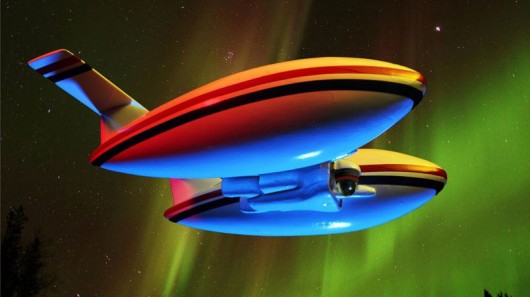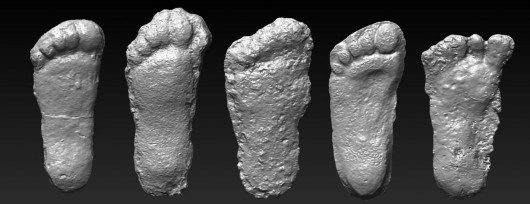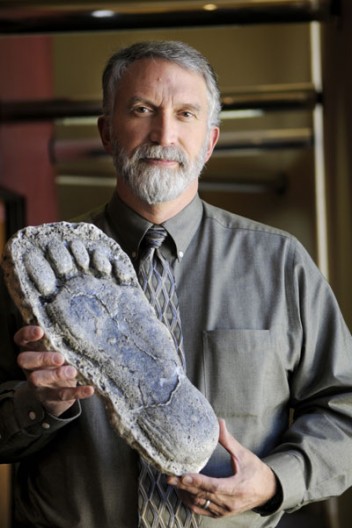Researchers plan to use one-of-a-kind airship to search for Bigfoot
By Ben Coxworth
October 12, 2012

An artist's rendering of the completed Aurora airship
Fifteen years ago, Utah-based prospector William A. Barnes was on a solo gold-dredging expedition in the wilds of Northern California. One night, he heard something disturbing the rocks in the canyon above his campsite. He proceeded to watch as that indistinct “something” came trudging downhill, until it stood only about three feet (0.9 meters) from his tent. At that point, upon seeing its size, shape, and profile against the brightly-moonlit quartz hillside, he became a firm believer in the legendary creature commonly referred to as Bigfoot or Sasquatch. In the years since, he has become obsessed with researching the animals. Now, as the founder of The Falcon Project, he hopes to prove their existence once and for all – with the help of a state-of-the-art remote-control camera-equipped airship.
So, why an airship? Unlike ground-based human explorers, it will be able to travel quickly and quietly over any terrain, it will have a high vantage point, and it will be able to see down between the trees. It also won’t need to stop and catch its breath or rest its feet.
The 45-foot (13.7-meter)-long Aurora airship will be the first one of its kind, designed and built by Canadian remote-control airship company RATS (Remote Aerial Tripod Specialists) Inc. It will consist of tandem side-by-side helium-filled envelopes, joined by a gyro-stabilized carbon fiber camera platform. That catamaran-like design will help keep it from rolling from side to side, which can be a problem with traditional single-envelope airships.
It will additionally feature a proprietary propulsion system, in which air will be drawn in and vectored through four ducts. This will allow for vertical take-off and landing capabilities, hovering on the spot, and more energy-efficient operation than traditional propellor-based systems.
Casts of what could be Bigfoot footprints (Image: Dr. Jeff Meldrum)
The Aurora will reportedly have a top air speed of 45 mph (72 km/h), and will be able to remain aloft for approximately three to four hours at a time. It will be remotely-piloted by Barnes and his team from a command center in a customized motorhome, and will be switched over to autopilot once it has reached altitude. Once switched over, it will be able to autonomously perform an aerial grid search, over an area within line-of-sight of the motorhome’s mast – Barnes estimates that its range could extend up to five miles (eight km) in any direction from the command center.
Mounted on the airship will be a gyro-stabilized thermal imaging/infrared/HD video camera, which is being built specifically for the project. The aircraft will also be equipped with carbon dioxide-recognition equipment, to detect the exhalations of animals in the forests beneath it. Barnes hopes to become familiar with the CO2 signatures of common creatures such as bears, so that he won’t get unnecessarily excited by every reading he gets. When something unusual shows up, however, the team will use to the camera’s powerful zoom lens to get a better look at it, while recording the images.
The ground crew will also be playing back and recording infrasound, as some people have theorized that Bigfoots use it to communicate with one another.
William A. Barnes, founder of The Falcon Project
Barnes told Gizmag that it should take less than an hour to assemble the airship every evening, after which it will embark on several flights each night. Its camera output will be streamed live on the internet, although there will be a “kill switch” in the command center – should a Bigfoot be spotted, viewers will only see the first few seconds, with the rest of the footage being saved for a planned educational documentary for the public. He hopes to record at least 45 minutes of smooth, clear Bigfoot footage (or perhaps “Bigfootage”?) for use in that film, half of the proceeds of which will go towards educating the public in wilderness conservation.
RATS, Inc. president Stephen Barkley said that he has hopes for the airship to be ready by early next spring (Northern Hemisphere). Once it is ready, Barnes plans on spending up to one year on the road, visiting Bigfoot-sighting hotspots in a total of 12 states.
Principal investigator on the project will be anthropologist Dr. Jeff Meldrum of Idaho State University, who has been an active Bigfoot researcher for the past 17 years. "The prospect of compelling DNA evidence for a relict North American primate looms on the horizon and may indicate that a corner is about to be turned," Meldrum told us. "[However] DNA sequence data can only tell us so much about sasquatch. What follows will be the challenge of studying a rare, reclusive, solitary, nocturnal primate species in the field. Aerial reconnaissance combined with thermal imaging, widely employed in wildlife studies, is a logical approach to meeting this challenge. The Falcon Project offers the advantage of the stealth and maneuverability capabilities of an unmanned helium-filled airship, over helicopter and fixed-wing aircraft. This is especially true in rugged remote forested terrain."
Idaho State University anthropologist Dr. Jeff Meldrum, with the cast of a footprint attributed to you-know-who
Not only will his involvement help lend the venture some mainstream credibility, but it will also allow Barnes to take the airship higher – as a civilian pilot he would be limited to an altitude of no more than 400 feet (122 meters), but as a member of a scientific expedition associated with a university, he can take it up to 7,500 feet (2,286 meters) or more.
The Falcon Project has been in the works for nearly three years, although the university’s involvement has helped make the actual expedition a lot more likely to happen. Barnes and his team are now seeking private funding or corporate sponsorship, although members of the public are also welcome to provide tax-deductible funding via the project’s website.
“We’re all about educating people on these creatures,” he told us. “Our goal is protection for them.”
Barnes, incidentally, doesn’t like to use the terms “Bigfoot” or “Sasquatch,” as he feels that they have become too closely associated with hoaxes and sensationalism. Instead, he prefers to call them “North American apes” or “hominoids.” Whatever you call them, and whether or not they actually exist, we definitely wish him luck in his endeavor.
About the Author
Copyright © gizmag 2003 - 2012 To subscribe or visit go to: http://www.gizmag.com



